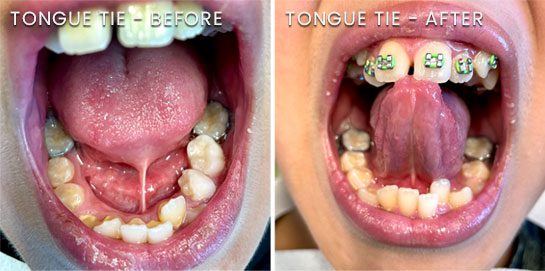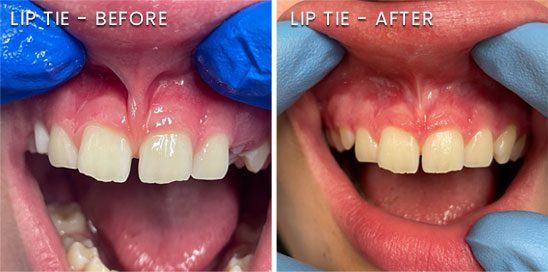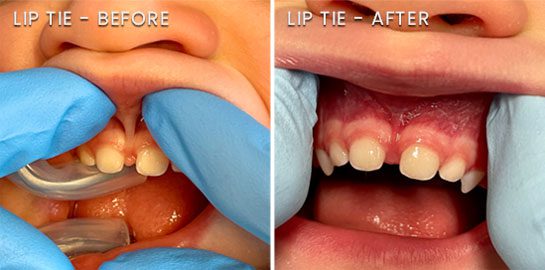TONGUE-TIE
& LIP-TIE
TREATMENTS
REQUEST AN APPOINTMENT
Our Dental Office Offers Comprehensive Tongue-Tie & Lip-Tie Treatments
Tongue-tie, known as ankyloglossia, is a congenital condition that researchers estimate affects around 10-20% of the world’s population.
Tongue-tie is a tight string of tissue under the tongue (lingual frenum) that restricts normal tongue movement and inhibits the tongue from functioning properly. This condition typically runs in the family. If the upper lip is restricted and cannot move freely, the condition is called lip-tie.
The dental specialists from Bear Brook Dental Care can properly treat tongue-tie and lip-tie using CO2 laser frenectomy treatments. As a family-friendly practice, we use innovative dental treatments and technologies to assist our patients with comprehensive tongue-tie and lip-tie treatments. If tongue-tie is left untreated, speech delays, eating difficulties which can cause picky eaters and frequent gag reflex, dental and airway issues, high palate, the avoidance of social settings, a lack of confidence, and difficulty of producing the sounds for L, R, T, D, N, TH, SH, and Z may become prevalent.
BEFORE AND AFTER CASE PHOTOS



Benefits of CO2 Laser Treatments
CO2 lasers are extremely precise and seal up the blood vessels and nerve endings during the tongue-tie procedure, so there is minimal-to-no bleeding.
Lasers also sterilize the surgical area and seal up the lymphatic vessels, which reduces the risk of infection, so our patients experience little to no swelling or pain after the completion of the procedure. Other benefits include fast surgical times and no need for general anesthesia.

<< Before & After
We encourage you to view our laser frenectomy video so you can see our CO2 laser frenectomy process for yourself.
Symptoms of Tongue-Tie
UNDERSTANDING THE SIGNS OF
TONGUE-TIE AND LIP-TIE CAN HELP YOUR CHILD BECOME DIAGNOSED AND TREATED AS SOON AS POSSIBLE

FOR THE BABY:
- Poor or shallow latch on the breast or bottle
- Slow or poor weight gain
(sometimes diagnosed as failure-to-thrive) - Reflux symptoms or frequent spitting up
- Excessive gas due to poor seal causing the swallowing of pockets of air
- Milk leaking from the corner of the mouth during feeding (soaking through multiple bibs for one feeding)
- Inability to hold a pacifier
- Clicking or smacking noises when nursing or feeding
- Fussiness
- Prolonged feeding time (>30 minutes per feeding)
- Short sleeping and frequent feeding
- Frequent gagging or choking during feeding
FOR THE MOTHER:
- Painful nursing
- Bleeding or cracked nipples
- Poor breast drainage
- Nipple distortion (flattened or lipstick shaped)
- Plugged ducts or mastitis
- Inability to nurse without using a nipple shield
- Exhaustion from the prolonged breastfeeding time
BENEFITS OF BREASTFEEDING
The World Health Organization recommends mothers breastfeed their infants for the
first six months of the child’s life for growth and development. After the first six months, it’s recommended to
continue breastfeeding up to the age of two or beyond as complementary foods are introduced.
Contact
Montvale
305 W. Grand Avenue, Suite #100
Montvale, NJ 07645
Tel: 201.746.9474
Email: info@bearbrookdentalcare.com
Opening Times:
Weekdays: 9 AM ~ 6 PM
Saturday: 9 AM ~ 4 PM
Hoboken
727 Adams Street
Hoboken, NJ 07030
Tel: 201.479.2752
Email: info@bearbrookkids.com
Opening Times:
Weekdays: 9:30 AM ~ 5:30 PM
Saturday: 9 AM ~ 3 PM